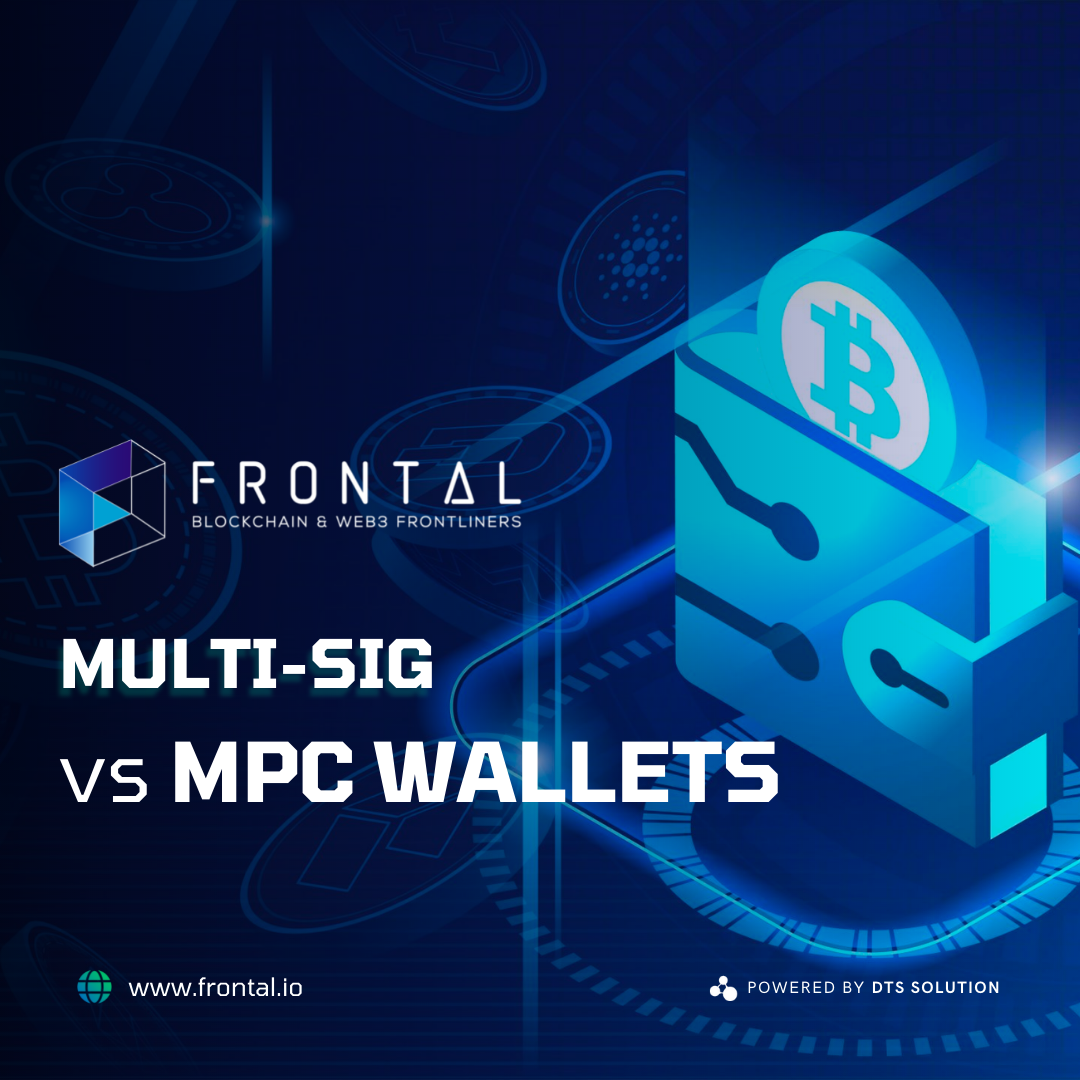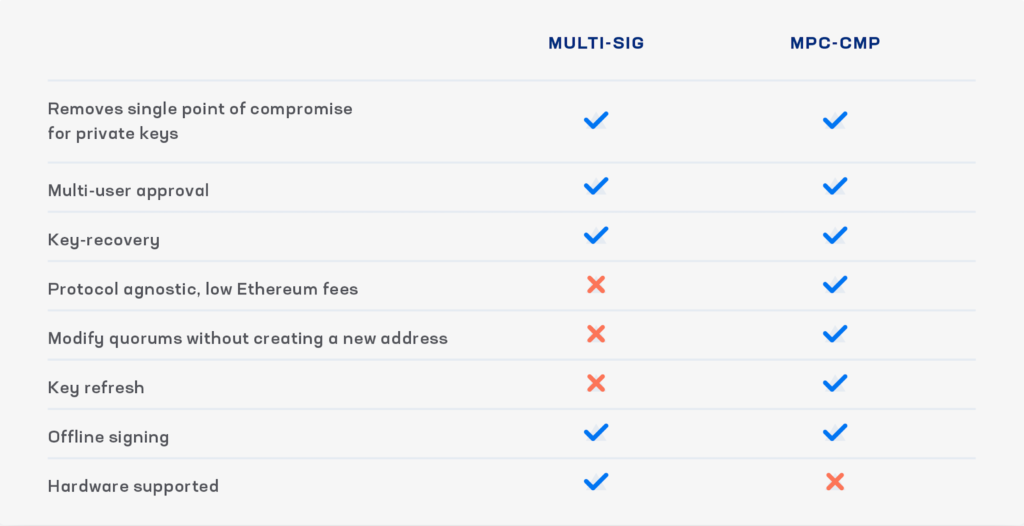MPC vs Multi-sig Wallets: Which is best for your Business
With fiat currency and paper notes, you can keep all of your money in a single wallet, even if you have 10 different currencies. On the flip side imagine getting separate wallets for Dollars, one for Dirhams, and another for Euros, that would be weird.
The same analogy goes for cryptocurrency, the burden of remembering different seed phrases for multiple wallets, managing multiple accounts, and all the security considerations required. it would be a difficult experience juggling these many wallets and digital assets. With Multi-Party Computation (MPC) based wallet it becomes a walk in the park. Some will argue that Multisig wallets are better.
In this blog post, we’ll walk you through everything you need to know about both technologies so you can get a better sense of which fits your organization’s needs.
What is a Multisig Wallet?
Multisig stands for “Multi-signature,” a particular kind of digital signature that enables two or more people to sign a document as a group. This adds an additional layer of security to your wallet compared to a single signature wallet which can easily be hacked.
What is a Multiparty computation(MPC) wallet?
MPC wallets, or multiparty computation wallets, are similar to Multisig Wallets but designed to provide the highest level of security to companies, banks, and governments looking to Manage their digital assets.
MPC removes the concept of a single private key; such a key is never gathered as a whole, neither during the first creation of the MPC wallet nor during the actual signature. MPC follows a set of steps to guarantee that there is never a single point of compromise of the private key:
- Individual secrets are randomized by each of the several (always more than 3) endpoints – either servers or mobile devices. Those secrets are never shared with each other.
- The individual endpoints engage in a decentralized wallet creation protocol in which they compute the public key (wallet address) that corresponds to the set of individual private shares.
- When a signature on a blockchain transaction is requested, a quorum (at least 3) of endpoints engage in a distributed signature process where each one of the endpoints individually validates the transaction and policy and signs the transaction.
In a similar fashion to multi-sig, the MPC private key protection layer removes the single point of compromise from both external hackers and insiders – as the private key is never concentrated on a single device at any point in time.
The Challenge with Multi-sig Wallets
Prior to Multisig wallets, cryptocurrencies were typically held using just one private key. The funds linked to a private key could be accessed by anyone with access to the private key itself. With multi-sig came an additional layer of security to the system. While Multisig wallets solved problems of single-signature wallets, they also introduced new issues; The main one being that Multi-signature wallets are not compatible with all crypto protocols. So, multi-signature wallet providers experience many issues in supporting new chains securely.
On the other hand, it is very slow as Wallet providers must implement different codes for each on-chain multi-signature solution.
In a nutshell, Multi-signature-based solutions are no longer able to meet the demands of a digital asset business in today’s rapidly evolving environment, with hundreds of cryptocurrencies and Blockchains.
Benefits of Using MPC over Multisig
1. MPC supports multichain
The Multisig challenge: More digital assets than ever are distributed across an increasing number of blockchain networks. Only a selected minority of these networks, like Bitcoin and Ethereum, have the technical ability to enable complex multi-signature schemes. They only support assets linked to that particular chain because the signature takes place on-chain.
For instance, Bitcoin Multisig only accepts BTC, whereas Ethereum Multisig only supports Ethereum-based currencies. This implies that you will require several signature solutions if your business deals with a large variety of digital assets.
The MPC Advantage: In comparison to Multisig, MPC wallet manages many assets for you on a single platform as opposed to juggling multiple signature systems. Presently the MPC wallet is compatible with Bitcoin, Ethereum-based assets, and will eventually support more digital assets across all blockchains.
2. Flexibility
The Multisig challenge: Onchain multisig is rigid, which makes it challenging for big digital asset businesses to scale. Fixed approval quorums are one of the main issues. To keep assets secure, signing methods must be continuously modified when new employees are employed and old ones are let go. However, as soon as an onchain multi-sig wallet is made, the approval quorum cannot be changed.
Therefore, in order to change the signature scheme and add or remove a cosigner, you must first create a new wallet, then pay network fees to transfer the funds, and finally inform all of your trading counterparties of the new address. Otherwise, you run the risk of them sending money to the wrong location!
The MPC Advantage: With MPC wallets, approval quorums are quickly adjusted to meet changing organizational requirements. Therefore, you can keep the same address rather than having to shift the full amount each time a cosigner is added or withdrawn, which would lessen the operational load and decrease the possibility of catastrophic errors like; large-scale data leakage,
3. Ease of Administration
The Multisig challenge: MPC gives you more control over governance than simply deciding how many employees must sign a transaction.
The MPC Advantage: You can assign an unlimited number of transaction approvers to a policy, and also delegate a variety of permissions that correspond to real-world organizational roles, such as administrators who can edit approval schemes and traders.
4. Low Gas fees
The Multisig challenge: The majority of blockchains charge network fees based on the number of onchain operations required to complete a transaction. As a result, the more people involved, the more expensive it is to carry out.
Bitcoin and Ethereum, for example, support simple multi-signature transactions. However, the added complexity of having multiple participants makes them much more computationally intensive, doubling or tripling the transaction cost.
The MPC Advantage: MPC-based wallets will never have fees that are higher than an ordinary transaction on the underlying chain, regardless of the number of signers involved.
5. Faster transactions
The Multisig challenge: Blockchains encounter a lot of network congestion, which pushes up transaction fees and poor processing rates. Additionally, as miners attempt to fit as many transactions as possible into each block, Multi-sig transactions are more likely to be put last because they take up more space and are larger due to the additional metadata they contain. Delays therefore cannot be avoided unless you are willing to pay more for expedited processing.
The MPC Advantage: In contrast, decentralized MPC does not rely on additional calculations made on the underlying chain. Instead, the signature calculation is done on the Network, and then just one small transaction is sent to the blockchain, avoiding long wait times and exorbitant transaction costs.
MPC vs. Multi-Sig breakdown


